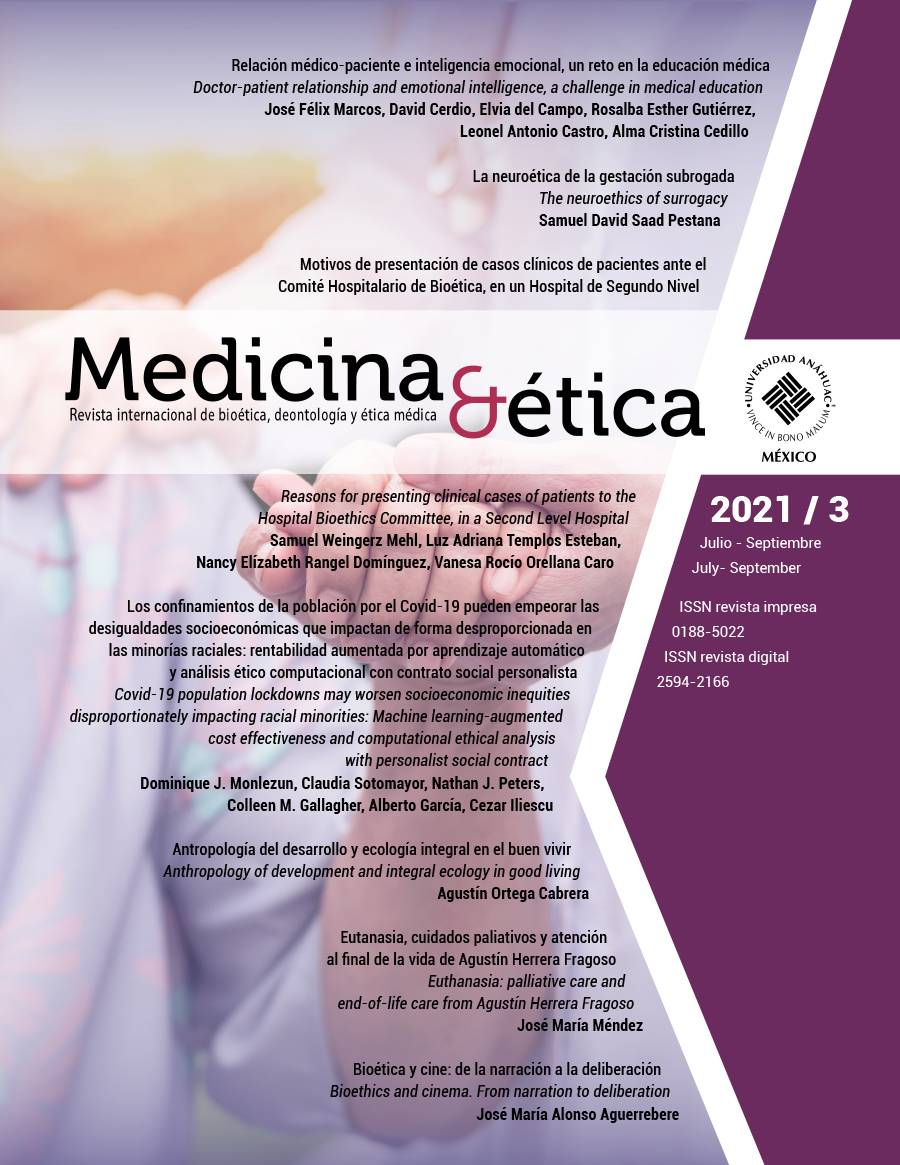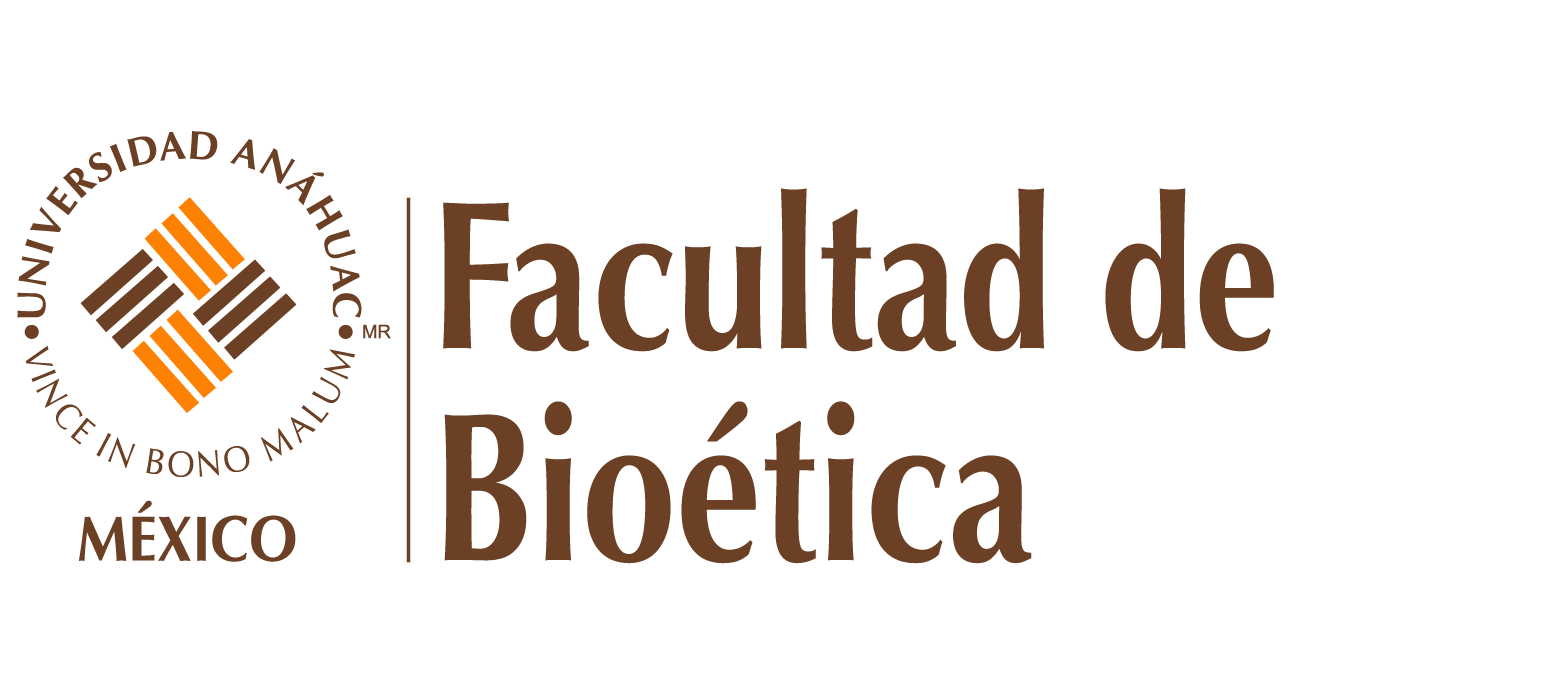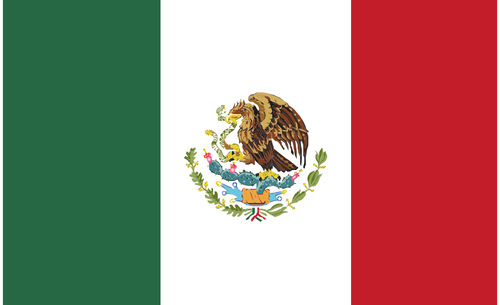Los confinamientos de la población por el Covid-19 pueden empeorar las desigualdades socioeconómicas que impactan de forma desproporcionada en las minorías raciales: rentabilidad aumentada por aprendizaje automático y análisis ético computacional
DOI:
https://doi.org/10.36105/mye.2021v32n3.04Palabras clave:
covid-19, equidad sanitaria, rentabilidad, bioética global, aprendizaje automáticoResumen
La nueva enfermedad del coronavirus de 2019 (Covid-19), producida por el coronavirus del Síndrome Respiratorio Agudo Severo 2 (SARS-CoV-2), es una pandemia que está creando una creciente crisis sanitaria mundial, dada su novedad, su alcance y sus inicialmente limitadas opciones de tratamiento eficaz. En efecto, se sabe poco acerca de las intervenciones no farmacéuticas óptimas para evitar la morbilidad y mortalidad causadas por él, y también se conoce poco sobre la rentabilidad y aspectos éticos de dichas intervenciones. Por lo tanto, éste es el primer análisis ético y de rentabilidad de las medidas de contención del Covid-19 que se conoce (así como de las medidas de cuarentena de la población para cualquier pandemia en particular), con el fin de ayudar a los sistemas de salud y a los gobiernos a garantizar la atención clínica más rentable que pueda proporcionarse equitativamente al mayor número posible de pacientes, durante esta pandemia y en las futuras crisis mundiales que sean similares. Este análisis utilizó la metodología adoptada por los Centros para el Control y la Prevención de Enfermedades (CDC), cifras comúnmente aceptadas como entradas, y los supuestos mínimos tanto extremos como del mundo real para proporcionar los resultados más sólidos y confiables posibles. El análisis de costos indicó que en los escenarios extremos, o en el mejor de los casos para las medidas de contención del Covid-19 durante la cuarentena de la población, hay una relación de costo-efectividad de $154.86 millones de dólares gastados por cada muerte evitada, y un costo neto de $1.92 billones a nivel mundial. En el mundo real, esta intervención tiene una proporción de 2,520 millones de dólares gastados por cada muerte evitada y un costo neto de 1,99 billones de dólares. La ética del contrato social personalista, tal y como se articula en el popular sistema ético de derechos y deberes de las Naciones Unidas, pone de manifiesto la especial preocupación por el hecho de que estos confinamientos pueden derivar en injusticias poco éticas perpetuadas por los Estados, de manera que socavan las vidas y las libertades individuales, al tiempo que afectan de manera des- proporcionada a las comunidades de menores ingresos, especialmente a las minorías raciales. Este estudio sugiere, por tanto, que la práctica prevalente de la cuarentena entre la población, en comparación con las precauciones de tipo estándar y las intervenciones más específicas, puede proporcionar un beneficio neto inadecuado por su costo financiero y ético. En un momento de escasez mundial, que pone a prueba la capacidad de los sistemas sanitarios para detectar y atender adecuadamente a los pacientes con Covid-19, especialmente en los países en desarrollo y en las comunidades desatendidas, este estudio respalda que se dediquen menos recursos a intervenciones con una relación costo- beneficio poco clara, y más recursos a intervenciones más asequibles, éticas y equitativas, con mayores pruebas de sus beneficios netos para salvar vidas.
Descargas
Referencias
2. Mintz M. Covid-19 Daily update: April 17, 2020. S&P Global. (Consultado el 17 de abril de 2020). Disponible en: https://www.spglobal.com/en/research-insights/arti- cles/covid-19-daily-update-april-14-2020 https://doi.org/10.26524/royal.37.6
3. Aledort JE, Lurie N, Wasserman J, Bozzette SA. Non-Pharmaceutical public health interventions for pandemic influenza: An evaluation of the evidence base. BMC Public Health. 2007; 7: 208. https://doi.org/10.1186/1471-2458-7-208
4. Nussbaumer-Streit B, Mayr V, Dobrescu AI, et. al. Quarantine alone or in combi- nation with other public health measures to control Covid 19: A rapid review. Co- chrane Database Systematic Reviews. 8 de abril de 2020; 4: CD013574. https://doi.org/10.1002/14651858.cd013574
5. Ioannidis JPA. Coronavirus disease 2019: The harms of exaggerated informa- tion and non-evidence-based measures. European Journal of Clinical Investiga- tion. 23 de marzo de 2020; e13223. https://doi.org/10.1111/eci.13223
6. Galea S, Tracy M, Hoggatt JK, Dimaggio C, Karpati A. Estimated deaths attribu- table to social factors in the United States. American Journal of Public Health. Agosto de 2011; 101(8): 1456-65. https://doi.org/10.2105/AJPH.2010.300086
7. Parmet WE, Sinha MS. Covid-19, the law and limits of quarantine. The New En- gland Journal of Medicine. 2020. https://doi.org/10.1056/NEJMp2004211
8. Russell LB, Sinha A. Strengthening cost-effectiveness analysis for public health policy. American Journal of Preventive Medicine. 2016; 50(5): S6-S12. https://doi.org/10.1016/j.amepre.2015.11.007
9. HME. Covid-19 health service utilization forecasting team. Forecasting Covid-19 impact on hospital bed-days, ICU-days, ventilator days and deaths by US State in the next 4 months. MedRxiv. 26 de marzo de 2020. https://doi.org/10.1101/2020.03.27.20043752
10. Boston Children’s Hospital HealthMap. Boston, MA: Covid-19, 2020. https://www.healthmap.org/covid-19
11. The United Nations. Universal Declaration of Human Rights. 1948. (Consulta- do el 6 de noviembre de 2020). Disponible en: https://www.un.org.
12. Nature. Why do Covid-19 death rates seem to be falling? (Consultado el 11 de noviembre de 2020). Disponible en: https://www.nature.com/articles/d41586-020- 03132-4
13. Monlezun DJ. The global bioethics of artificial intelligence and human rights. Cambridge Scholars Publishing, 2020.
14. García A, Lunstroth J, Monlezun DJ, Sotomayor CR. Convergence of human rights and duties: Towards a global bioethics. In: Tham J, Kwan K, García A (eds). Religious perspectives on bioethics and human rights. Advancing Global Bio- ethics, vol 6. Springer, Cham. https://doi.org/10.1007/978-3-319-58431-7_4
15. Monlezun DJ. Getting (human) value-based payments right: Neuroeconomic personalism in Thomistic-influenced human rights and duties-based global bio- ethics (THRD-GB). Journal of Medicine and the Person. 2015; 13(2): 135-136. https://doi.org/10.1007/s12682-015-0209-6
16. Pew Research Center. The changing global religious landscape. 2017. (Con- sultado el 6 de noviembre de 2020). Disponible en: https://www.pewforum.org
17. Rómulo, Carlos. «Natural law and international law» in Natural Law Institute proceedings, Vol. 3, Edward Barrett (ed.). South Bend: University of Notre Dame Press. 1950.
18. Smith S. Aristotle’s Logic. In: Zalta EN (ed.) The Stanford Encyclopedia of Phi- losophy: Fall 2020 Edition. Stanford University, 2020. (Consultado el 6 de noviem- bre de 2020). Disponible en: https://plato.stanford.edu/archives/fall2020/entries/ aristotle-logic
19. Orlik T, Rush J, Cousin M, Hong J. Coronavirus could cost the global economy $2.7 trillion. Bloomberg. (Consultado el 17 de abril de 2020). Disponible en: https:/ /www.bloomberg.com/graphics/2020coronaviruspandemicglobaleconomicrisk/
20. The Coronavirus shock: A story of another global crisis foretold and what poli- cymakers should be doing about it. Geneva: United Nation Conference on Trade and Development, 2020. Disponible en: https://unctad.org/system/files/official-docu- ment/gds_tdr2019_update_coronavirus.pdf https://doi.org/10.18356/4845ca36-en 21. Covid-19 Test Pricing. Baltimore: US Centers for Medicare & Medicaid Servi- ces, 2020. Disponible en: https://www.cms.gov
22. Guidelines for Preparing Economic Analyses. Washington, DC: US Environ- mental Protection Agency, 2010. Disponible en: https://www.epa.gov
23. Meyerowitz-Katza G, Meronec L. A systematic review and meta-analysis of pu- blished research data on Covid-19 infection fatality rates. Int J Infect Dis. Diciem- bre de 2020; 101: 138-148. https://doi.org/10.1016/j.ijid.2020.09.1464
24. United Nations. Covid-19 to slash global economic output by $8.5 trillion over next two years. (Consultado el 13 de mayo de 2020). Disponible en: https://www.- un.org/development/desa/en/news/policy/wesp-mid-2020-report.html
25. World Bank. Covid-19 to Plunge Global Economy into Worst Recession since World War II. (Consultado el 8 de junio de 2020). Disponible en: https://www.world- bank.org/en/news/press-release/2020/06/08/covid-19-to-plunge-global-economy- into-worst-recession-since-world-war-ii https://doi.org/10.36880/c12.02467
26. Global spending on health: a world in transition. Geneva: World Health Orga- nization; 2019. (WHO/HIS/HGF/HFWorkingPaper/19.4). License: CC BY-NC-SA 3.0 IGO. 27. Khazanchi R, Evans CT, Marcelin JR. Racism, not race, drives inequity across the covid-19 continuum. JAMA. 2020. https://doi.org/10.1001/jamanetworkopen.2020.19933
28. Boyd RW, Lindo EG, Weeks LD, McLemore MR. On racism: A new standard for publishing on racial health inequities. Health Affairs. 2020. Disponible en: https://www.healthaffairs.org/do/10.1377/hblog20200630.939347/full/ https://doi.org/10.1377/hblog20200630.939347.
29. World Health Organization. Coronavirus disease (Covid-19): Herd immunity, lockdowns and Covid-19. (Consultado el 15 de octubre de 2020). Disponible en: https://www.who.int/news-room/q-a-detail/herd-immunity-lockdowns-and-covid-19 https://doi.org/10.2172/1659688
30. World Health Organization. Cardiovascular diseases. (Consultado el 11 de no- viembre de 2020). Disponible en: https://www. who.int/health-topics/cardiovascular- diseases/#tab=tab_1
31. Ioannidis JP. Infection fatality rate of Covid-19 inferred from seroprevalence data. World Health Organization Bulletin. (Consultado el 4 de octubre de 2020). Disponible en: https://www.who.int/bulletin/online_first/BLT.20.265892.pdf https://doi.org/10.2471/blt.20.265892
Descargas
Publicado
Número
Sección
Licencia
Derechos de autor 2021 Dominique J. Monlezun, Dr., Claudia Sotomayor, Dra., Nathan J. Peters, Dr., Colleen M. Gallagher, Dra., Alberto García, Dr., Cezar Iliescu, Dr.

Esta obra está bajo una licencia internacional Creative Commons Atribución-NoComercial-CompartirIgual 4.0.
Medicina y Ética se distribuye bajo Licencia Creative Commons Atribución-NoComercial-CompartirIgual 4.0 Internacional.
El autor conserva los derechos patrimoniales sin restricciones y garantiza a la revista el derecho de ser la primera publicación del trabajo. El autor es libre de depositar la versión publicada en cualquier otro medio, como un repositorio institucional o en su propio sitio web.



























